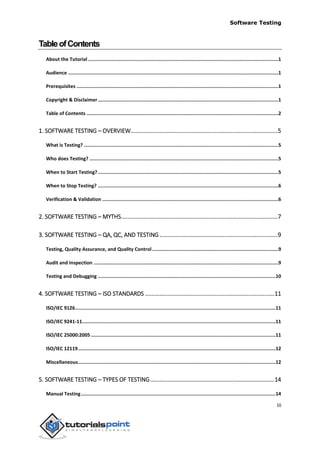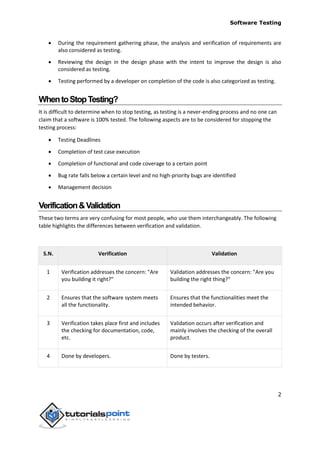Software testing tutorial
- 2. Software Testing ii AbouttheTutorial Testing is the process of evaluating a system or its component(s) with the intent to find whether it satisfies the specified requirements or not. Testing is executing a system in order to identify any gaps, errors, or missing requirements in contrary to the actual requirements. This tutorial will give you a basic understanding on software testing, its types, methods, levels, and other related terminologies. Audience This tutorial is designed for software testing professionals who would like to understand the Testing Framework in detail along with its types, methods, and levels. This tutorial provides enough ingredients to start with the software testing process from where you can take yourself to higher levels of expertise. Prerequisites Before proceeding with this tutorial, you should have a basic understanding of the software development life cycle (SDLC). In addition, you should have a basic understanding of software programming using any programming language. Copyright&Disclaimer Copyright 2018 by Tutorials Point (I) Pvt. Ltd. All the content and graphics published in this e-book are the property of Tutorials Point (I) Pvt. Ltd. The user of this e-book is prohibited to reuse, retain, copy, distribute or republish any contents or a part of contents of this e-book in any manner without written consent of the publisher. We strive to update the contents of our website and tutorials as timely and as precisely as possible, however, the contents may contain inaccuracies or errors. Tutorials Point (I) Pvt. Ltd. provides no guarantee regarding the accuracy, timeliness or completeness of our website or its contents including this tutorial. If you discover any errors on our website or in this tutorial, please notify us at [email protected]
- 3. Software Testing iii TableofContents About the Tutorial ......................................................................................................................................1 Audience ....................................................................................................................................................1 Prerequisites ..............................................................................................................................................1 Copyright & Disclaimer...............................................................................................................................1 Table of Contents .......................................................................................................................................2 1. SOFTWARE TESTING – OVERVIEW...........................................................................................5 What is Testing? .........................................................................................................................................5 Who does Testing? .....................................................................................................................................5 When to Start Testing?...............................................................................................................................5 When to Stop Testing? ...............................................................................................................................6 Verification & Validation ............................................................................................................................6 2. SOFTWARE TESTING – MYTHS.................................................................................................7 3. SOFTWARE TESTING – QA, QC, AND TESTING .........................................................................9 Testing, Quality Assurance, and Quality Control.........................................................................................9 Audit and Inspection ..................................................................................................................................9 Testing and Debugging .............................................................................................................................10 4. SOFTWARE TESTING – ISO STANDARDS ................................................................................11 ISO/IEC 9126.............................................................................................................................................11 ISO/IEC 9241-11........................................................................................................................................11 ISO/IEC 25000:2005 ..................................................................................................................................11 ISO/IEC 12119...........................................................................................................................................12 Miscellaneous...........................................................................................................................................12 5. SOFTWARE TESTING – TYPES OF TESTING.............................................................................14 Manual Testing.........................................................................................................................................14
- 4. Software Testing iv Automation Testing..................................................................................................................................14 What to Automate?..................................................................................................................................14 When to Automate?.................................................................................................................................15 How to Automate? ...................................................................................................................................15 Software Testing Tools .............................................................................................................................15 6. SOFTWARE TESTING – TESTING METHODS ...........................................................................17 Black-Box Testing......................................................................................................................................17 White-Box Testing ....................................................................................................................................17 Grey-Box Testing ......................................................................................................................................18 A Comparison of Testing Methods............................................................................................................19 7. SOFTWARE TESTING – TESTING LEVELS.................................................................................20 Functional Testing ....................................................................................................................................20 Unit Testing ..............................................................................................................................................20 Integration Testing ...................................................................................................................................21 System Testing .........................................................................................................................................21 Regression Testing....................................................................................................................................22 Acceptance Testing...................................................................................................................................22 Non-Functional Testing.............................................................................................................................23 Usability Testing .......................................................................................................................................24 Security Testing ........................................................................................................................................25 Portability Testing ....................................................................................................................................26 8. SOFTWARE TESTING – DOCUMENTATION.............................................................................27 Test Plan...................................................................................................................................................27 Test Scenario ............................................................................................................................................27 Test Case ..................................................................................................................................................28 Traceability Matrix ...................................................................................................................................29
- 5. Software Testing v 9. SOFTWARE TESTING – ESTIMATION TECHNIQUES ................................................................30 Functional Point Analysis..........................................................................................................................30 Test Point Analysis....................................................................................................................................30 Mark-II Method ........................................................................................................................................30 Miscellaneous...........................................................................................................................................30
- 6. Software Testing 1 WhatisTesting? Testing is the process of evaluating a system or its component(s) with the intent to find whether it satisfies the specified requirements or not. In simple words, testing is executing a system in order to identify any gaps, errors, or missing requirements in contrary to the actual requirements. According to ANSI/IEEE 1059 standard, Testing can be defined as - A process of analyzing a software item to detect the differences between existing and required conditions (that is defects/errors/bugs) and to evaluate the features of the software item. WhodoesTesting? It depends on the process and the associated stakeholders of the project(s). In the IT industry, large companies have a team with responsibilities to evaluate the developed software in context of the given requirements. Moreover, developers also conduct testing which is called Unit Testing. In most cases, the following professionals are involved in testing a system within their respective capacities: Software Tester Software Developer Project Lead/Manager End User Different companies have different designations for people who test the software on the basis of their experience and knowledge such as Software Tester, Software Quality Assurance Engineer, QA Analyst, etc. It is not possible to test the software at any time during its cycle. The next two sections state when testing should be started and when to end it during the SDLC. WhentoStartTesting? An early start to testing reduces the cost and time to rework and produce error-free software that is delivered to the client. However in Software Development Life Cycle (SDLC), testing can be started from the Requirements Gathering phase and continued till the deployment of the software. It also depends on the development model that is being used. For example, in the Waterfall model, formal testing is conducted in the testing phase; but in the incremental model, testing is performed at the end of every increment/iteration and the whole application is tested at the end. Testing is done in different forms at every phase of SDLC: 1. Software Testing – Overview
- 7. Software Testing 2 During the requirement gathering phase, the analysis and verification of requirements are also considered as testing. Reviewing the design in the design phase with the intent to improve the design is also considered as testing. Testing performed by a developer on completion of the code is also categorized as testing. WhentoStopTesting? It is difficult to determine when to stop testing, as testing is a never-ending process and no one can claim that a software is 100% tested. The following aspects are to be considered for stopping the testing process: Testing Deadlines Completion of test case execution Completion of functional and code coverage to a certain point Bug rate falls below a certain level and no high-priority bugs are identified Management decision Verification&Validation These two terms are very confusing for most people, who use them interchangeably. The following table highlights the differences between verification and validation. S.N. Verification Validation 1 Verification addresses the concern: "Are you building it right?" Validation addresses the concern: "Are you building the right thing?" 2 Ensures that the software system meets all the functionality. Ensures that the functionalities meet the intended behavior. 3 Verification takes place first and includes the checking for documentation, code, etc. Validation occurs after verification and mainly involves the checking of the overall product. 4 Done by developers. Done by testers.
- 8. Software Testing 3 5 It has static activities, as it includes collecting reviews, walkthroughs, and inspections to verify a software. It has dynamic activities, as it includes executing the software against the requirements. 6 It is an objective process and no subjective decision should be needed to verify a software. It is a subjective process and involves subjective decisions on how well a software works.
- 9. Software Testing 4 Given below are some of the most common myths about software testing. Myth 1: Testing is Too Expensive Reality: There is a saying, pay less for testing during software development or pay more for maintenance or correction later. Early testing saves both time and cost in many aspects, however reducing the cost without testing may result in improper design of a software application rendering the product useless. Myth 2: Testing is Time-Consuming Reality: During the SDLC phases, testing is never a time-consuming process. However diagnosing and fixing the errors identified during proper testing is a time-consuming but productive activity. Myth 3: Only Fully Developed Products are Tested Reality: No doubt, testing depends on the source code but reviewing requirements and developing test cases is independent from the developed code. However iterative or incremental approach as a development life cycle model may reduce the dependency of testing on the fully developed software. Myth 4: Complete Testing is Possible Reality: It becomes an issue when a client or tester thinks that complete testing is possible. It is possible that all paths have been tested by the team but occurrence of complete testing is never possible. There might be some scenarios that are never executed by the test team or the client during the software development life cycle and may be executed once the project has been deployed. Myth 5: A Tested Software is Bug-Free Reality: This is a very common myth that the clients, project managers, and the management team believes in. No one can claim with absolute certainty that a software application is 100% bug-free even if a tester with superb testing skills has tested the application. Myth 6: Missed Defects are due to Testers Reality: It is not a correct approach to blame testers for bugs that remain in the application even after testing has been performed. This myth relates to Time, Cost, and Requirements changing Constraints. However the test strategy may also result in bugs being missed by the testing team. 2. Software Testing – Myths
- 10. Software Testing 5 Myth 7: Testers are Responsible for Quality of Product Reality: It is a very common misinterpretation that only testers or the testing team should be responsible for product quality. Testers’ responsibilities include the identification of bugs to the stakeholders and then it is their decision whether they will fix the bug or release the software. Releasing the software at the time puts more pressure on the testers, as they will be blamed for any error. Myth 8: Test Automation should be used Wherever Possible to Reduce Time Reality: Yes, it is true that Test Automation reduces the testing time, but it is not possible to start test automation at any time during software development. Test automaton should be started when the software has been manually tested and is stable to some extent. Moreover, test automation can never be used if requirements keep changing. Myth 9: Anyone can Test a Software Application Reality: People outside the IT industry think and even believe that anyone can test a software and testing is not a creative job. However testers know very well that this is a myth. Thinking alternative scenarios, try to crash a software with the intent to explore potential bugs is not possible for the person who developed it. Myth 10: A Tester’s Only Task is to Find Bugs Reality: Finding bugs in a software is the task of the testers, but at the same time, they are domain experts of the particular software. Developers are only responsible for the specific component or area that is assigned to them but testers understand the overall workings of the software, what the dependencies are, and the impacts of one module on another module.
- 11. Software Testing 6 End of ebook preview If you liked what you saw… Buy it from our store @ https://store.tutorialspoint.com




















































































![[HIFLUX] Lok Fitting&Valve Catalog 2025 (Eng)](https://cdn.slidesharecdn.com/ss_thumbnails/lokfittingen-250528072439-8696f1c6-thumbnail.jpg?width=560&fit=bounds)









